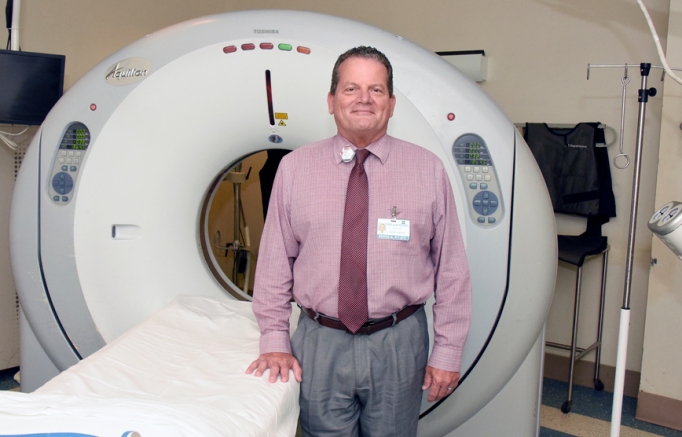The Right Place for Stroke Care

Dennis Nobles believes he was at the right place at the right time when he had a stroke in September 2019. It was after lunch and Dennis was feeling cold. However, his office at McLeod Regional Medical Center, where he serves as the Assistant Director of Radiology, tends to run cold. Dennis decided to walk out to his car to warm up for a few minutes.
When he was ready to go back inside, he got out of his car and started heading towards the employee entrance. When he placed his foot down taking about his third step, Dennis realized his right foot started to feel numb. As he continued to walk the numbness progressed up his leg. By the time he reached the door it had moved up to include his arm.
“I was hoping once I got inside the employee hallway there would be someone there that could help me get to the McLeod Emergency Department,” said Dennis. “It was unusual, but there was no one around when I got into the hallway.”
Dennis’s entire right side was now numb, but he managed to get himself to the Emergency Department. Once there he saw Tammie Campbell, Assistant Director of Nursing for McLeod Emergency Services. Dennis told Tammie he needed help. He was immediately placed on a stretcher. Once he explained his symptoms a Stroke Alert was called.
McLeod Stroke Alert Nurse Candace Norton came to assist. “A Stroke Alert Nurse is an expert in stroke,” said JoAnne Hutchinson, RN, McLeod Stroke Coordinator. “They are trained in the rapid recognition, assessment, treatment and management of stroke care. They take control of the care of the stroke patient, and never leave the bedside until the patient is relocated to the Stroke Unit.”
The first step in stroke treatment is a CT scan of the brain to see if a blood clot, an Ischemic Stroke, was the cause of the stroke. Ischemic Strokes happen when a clot blocks a vessel supplying blood to the brain. They are the most common type of stroke and account for 87 percent of all strokes. The treatment for Ischemic Strokes is clot removal, which can be accomplished with medication. The medication gold standard is tissue plasminogen activator or tPA. It dissolves the clot and improves blood flow to the brain but tPA must be administered within three to four and a half hours of the onset of the stroke. It is important that the physician know before administering any type of treatment if the patient has a brain bleed or a clot in the vessel that is the cause of their stroke. A CT scan is available 24 hours a day, seven days a week to the Emergency Department for a diagnostic brain scan to assist physicians in classifying the type of stroke.
Dennis gave permission for the tPA treatment. “Within the first two to three hours of having the tPA injection I could already tell the difference. My arm was the first area the feeling returned to. My leg took longer.”
From the Emergency Department Dennis was transported to the McLeod Stroke Unit. Dedicated to the care of stroke patients, McLeod opened the first Stroke Unit in the region in 2000. It is dedicated exclusively to the treatment and care of patients who have suffered a stroke. The 20-bed unit is staffed by specialty trained nurses who recognize even subtle changes in their patients’ condition.
Dennis suffered his stroke on a Tuesday. He spent two days in the Stroke Unit and returned to work on Friday.
‘I wasn’t thinking stroke that afternoon I just knew I needed help,” said Dennis. “It wasn’t until I arrived at the Emergency Department that I realized I was having a stroke.
“I couldn’t have gotten better care. The teams in the Emergency Department and Stroke Unit were awesome. McLeod is the perfect place for care if you are experiencing stroke symptoms,” added Dennis.
Every minute counts for stroke patients and acting F.A.S.T. can lead patients to the stroke treatments they desperately need. The most effective stroke treatments are only available if the stroke is recognized and diagnosed within the first three hours of the first symptoms. Actually, many Americans are not aware that stroke patients may not be eligible for stroke treatments if they arrive at the hospital after the three-hour window.
If you think someone may be having a stroke, act F.A.S.T. and do this simple test:
F-FACE: Ask the person to smile. Does one side of the face droop?
A-ARMS: Ask the person to raise both arms. Does one arm drift downward?
S-SPEECH: Ask the person to repeat a simple phrase. Is their speech slurred or strange?
T-TIME: If you observe any of these signs, call 9-1-1 immediately.
-
McLEOD REGIONAL MEDICAL CENTER FLORENCE
843-777-2000 -
McLEOD DARLINGTON
843-777-1100 -
McLEOD DILLON
843-774-4111 -
McLEOD LORIS
843-716-7000 -
McLEOD SEACOAST
843-390-8100 -
McLEOD CHERAW
843-537-7881 -
McLEOD CLARENDON
803-433-3000



-
McLEOD REGIONAL MEDICAL CENTER FLORENCE
843-777-2000 -
McLEOD DARLINGTON
843-777-1100 -
McLEOD DILLON
843-774-4111 -
McLEOD LORIS
843-716-7000 -
McLEOD SEACOAST
843-390-8100 -
McLEOD CHERAW
843-537-7881 -
McLEOD CLARENDON
803-433-3000
 Find a Doctor
Find a Doctor  Locations
Locations  Services
Services